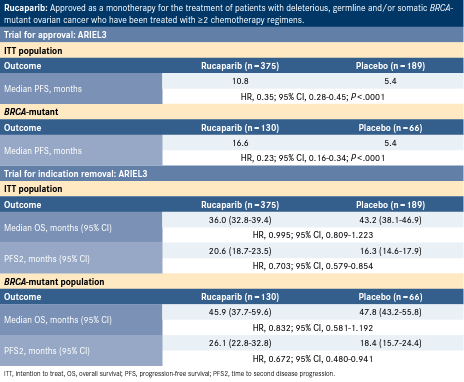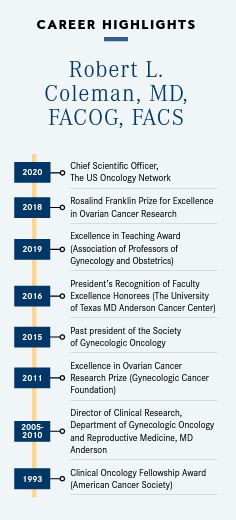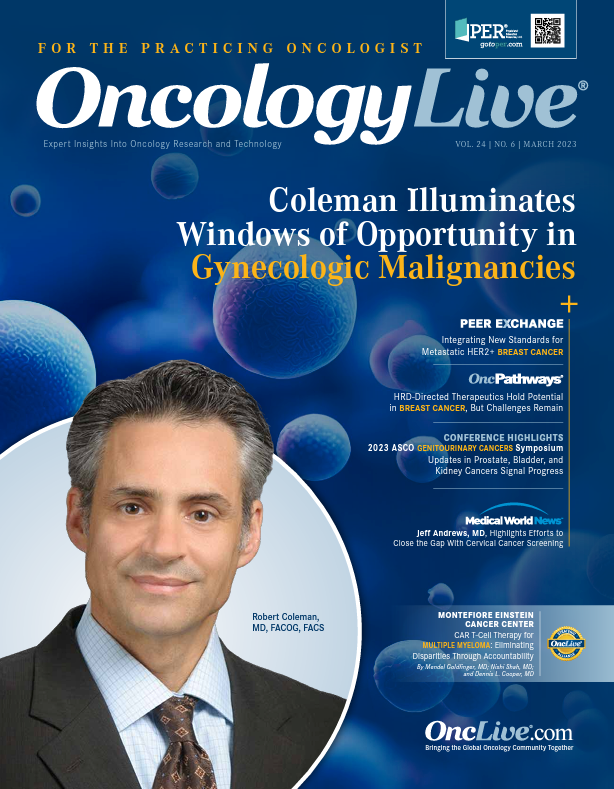Coleman Illuminates Opportunities in Gynecologic Malignancies
Robert L. Coleman, MD, FACOG, FACS, the 2020 Giants of Cancer Care® award winner in gynecologic malignancies, notes that despite the great progress in the past decade, more work is needed to personalize and refine approaches to care.
Robert L. Coleman, MD, FACOG, FACS

During the past decade, standards of care across gynecologic malignancies have undergone a transformation as gynecologic oncologists have been tasked with incorporating first-line PARP inhibitors, targeted therapies for rare malignancies, and immunotherapy in endometrial and cervical cancers.
“There’s a lot of going on after coming through basically a desert of drug development in the mid 2010s, with the evolution of the PARP inhibitors in ovarian and cervical cancer, and then the arrival of immunotherapy…we’ve seen a dramatic change in the way we approach these diseases,” Robert L. Coleman, MD, FACOG, FACS, chief medical officer of Sarah Cannon Research Institute and an oncologist with Texas Oncology, a practice in The US Oncology Network, said in an interview with OncologyLive®.
For the past 20 years, he has been a prominent leader in clinical research, particularly in the field of gynecologic oncology, and he brings this expertise to his role as cochair of the 14th Annual International Symposium on Ovarian Cancer and Other Gynecologic Malignancies® to be hosted by Physicians’ Education Resource® (PER®), LLC, on May 13.
“At the meeting, we’ll have an opportunity to highlight new compounds and approaches, as we look at the antibody-drug conjugates [ADCs], oncological viruses, and various other targeted, directed approaches based on genomic sequencing,” Coleman added.
The Evolving Story of PARP
Frontline maintenance with PARP inhibitors has played a significant role in shifting gynecologic standards of care. In the recurrent setting, however, indications granted to such agents as rucaparib (Rubraca), niraparib (Zejula), and olaparib (Lynparza) were removed after confirmatory data failed to reflect a benefit in overall survival (OS) for patients compared with standard-of-care measures.1-4
“All the [PARP inhibitor] retractions are essentially in the recurrent setting,” Coleman said. “There are those occasional patients who’ve never seen a PARP inhibitor who would be potentially eligible for PARP inhibitor [after] recurrence, but they’re getting less and less [frequent] as time goes on,” he noted, adding that this is because of the success of PARP inhibitors in the front line. “The impact at the clinic level [is] probably not quite as strong. But…the concern I have is more around how those decisions were made, how the data are being interpreted.”
In June 2022 manufacturers began the process of voluntarily withdrawing rucaparib indications for the treatment of patients with BRCA-mutated ovarian cancer after at least 2 prior chemotherapies.1 This was followed in August of the same year by olaparib’s losing an indication for the treatment of adults with BRCA-mutated advanced ovarian cancer who had received at least 3 prior lines of chemotherapy2 and the removal that September of its indication for the treatment of patients with homologous recombination deficiency–positive ovarian cancer after 3 or more lines of chemotherapy.3 Each removal was prompted by confirmatory OS data that failed to demonstrate a benefit with prolonged PARP inhibitor therapy.1-4
The removal process is ongoing in the recurrent setting, with rucaparib and niraparib facing additional removals. In November 2022, the FDA requested that Clovis Oncology, the developer of rucaparib, limit its use to second-line maintenance therapy in patients with recurrent ovarian cancer harboring BRCA mutations.5
Despite the failure of final data from the ARIEL 3 trial (NCT01968213) to show an OS benefit with rucaparib, the progression-free survival (PFS) benefit that had supported its accelerated approval was maintained (Table).6,7 The median PFS in the BRCA-mutant cohort was 16.6 months with rucaparib vs 5.4 months with placebo, with an HR of 0.20 per blinded independent central review (95% CI, 0.13-0.32; P < .0001) and 0.23 per investigator assessment (95% CI, 0.16-0.34; P < .0001). In the intention-to-treat (ITT) population, the median PFS was 10.8 months vs 5.4 months (HR, 0.35; 95% CI, 0.280.45; P < .0001).6
According to Colman, the study’s lead author, “the retractions were rooted in OS, what [the FDA] considers a disadvantage or detriment, without acknowledging the very difficult situation of trying to control for postprogression therapy duration, the postprogression treatments themselves, and other confounding variables such as access [available therapies]. I think these [data] are hypothesis-generating, and they should not have been…[interpreted] as making definitive statements regarding what’s available to patients without formal investigation.”
In the BRCA-mutant cohort, the median OS was 45.9 months (95% CI, 37.7-59.6) with rucaparib (n = 130) and 47.8 months (95% CI, 43.2-55.8) with placebo (n = 66; HR, 0.832; 95% CI, 0.5811.192).6 Among patients in the rucaparib group, 34.0% received a PARP inhibitor during subsequent treatment (any), compared with 71.7% of those in the placebo arm.7
In the ITT population, the median OS was 36.0 months (95% CI, 32.8-39.4) with rucaparib (n = 375) and 43.2 months (95% CI, 38.146.9) with placebo (n = 189; HR, 0.995; 95% CI, 0.809-1.223). The rates of PARP inhibitor use as a subsequent therapy were 20.8% and 45.8%, respectively.7
“The time frame in which [patients] ultimately get to a next line of therapy is extended by using a PARP [inhibitor],” Coleman said. In the time to second disease progression (PFS2), the advantage was seen in the rucaparib arm. The median PFS2 among patients in the BRCA-mutant cohort was 26.1 months (95% CI, 22.8-32.8) vs 18.4 months (95% CI, 15.7-24.4; HR, 0.672; 95% CI, 0.480-0.941).6 In the ITT population, the median PFS2 was 20.6 months (95% CI, 18.7-23.5) vs 16.3 (95% CI, 14.6-17.9) with rucaparib and placebo, respectively (HR, 0.703; 95% CI, 0.579-0.854).7
The first-line management of ovarian cancer began to show progress with the introduction of bevacizumab (Avastin) in 2011, based on data from the phase 3 GOG-0218 study (NCT00262847).8
It took nearly 9 nears for another advance to be made in the front-line setting, and it came with the advent of olaparib for patients with BRCA-mutant ovarian cancer, based on data from the SOLO-1 study (NCT0184498). A year later, 4 studies—of olaparib plus bevacizumab (PAOLA-1; NCT02477644), niraparib (PRIMA; NCT02655016), veliparib (VELIA; NCT02470585), and rucaparib (ATHENA; NCT02432458)—all demonstrated positive results in the front-line setting, regardless of BRCA status.9
With these advances and agents integrated into practice, the treatment landscape in the later-line setting stands to be reevaluated. ARIEL3 was conducted in heavily pretreated patients who were PARP inhibitor–naïve. Approaches to these patients include conducting trials to evaluate those who have received PARP maintenance, to look for other innovative options like ADCs and vaccinations in the relapse setting, and to differentiate tumors based on oncogenic drivers.
Table. ARIEL3 Data for Rucaparib Approval and Removal as Maintenance Therapy for Recurrent Disease6,7

“[We’re set to have a] very innovative next couple of months,” Coleman said. “We’ll have an integrative change in primary therapy for endometrial cancers. I think this will be important not only for patients in that setting, but it will also affect…what happens to patients downstream after they’ve had exposure to [therapies such as] immune checkpoint inhibitors. What do we do in those situations? Because right now, we have a lot of therapies that are approved in the recurrent setting, but they’re all predicated on lack of exposure in…[an] earlier [line].”
This leads to a topic that is top of mind in gynecologic oncology drug development: trial design. For Coleman, the question is “How do we strategically develop clinical trials so that we can get new compounds to patients fastest?” The answer is “a very strategic approach” that requires investigators know the therapeutic landscape and the regulatory environment so they can optimize each phase of the process, “spend the least amount of time doing the enrolling, and get to an end point that we can [evaluate].” These studies, he emphasized, are carefully crafted; “it wasn’t just drug A vs drug B with no thought behind it.” Important items to consider here include the magnitude of a drug’s effect, a key component of which, as Coleman explained, is the trial’s sample size. “Although we won’t specifically talk about this [at the symposium]…my hope is that it will come out in discussion so that attendees can see that a lot of what…[goes into] crafting these trials is intense, and… deliberate. Ultimately, we must get these trials enrolled. We really want to inspire those who are attending to…participate in the process, either by accruing the trials or leading them.”
Drug Approvals Underscore Importance of Markers
New drug approvals have been scarce for patients with platinum-resistant disease. The ADC mirvetuximab soravtansine-gynx (Elahere), although approved only for a small subset of patients, highlights the significance of examining biomarker-driven therapies for this patient population. Mirvetuximab soravtansine targets folate receptor–α (FRα) and was evaluated in the single-arm phase 3 SORAYA study (NCT04296890) for platinum-resistant epithelial ovarian, tubal, and primary peritoneal cancer in patients who had received 1 to 3 prior lines of therapy. Among 104 evaluable patients, the confirmed overall response rate was 31.7% (95% CI, 22.9%-41.6%), with a median duration of response of 6.9 months (95% CI, 5.6-9.7).10
For symposium cochair Ursula A. Matulonis, MD, who spoke with OncologyLive when mirvetuximab soravtansine was approved, the problem is that platinum-resistant ovarian cancer is difficult to treat. It becomes recurrent, then platinum-sensitive, and finally platinum-resistant so that “each treatment… has less efficacy.” Although this cancer is challenge, the addition of bevacizumab to nonplatinum chemotherapy had been quite effective. But now that “PARP inhibitors should not be used in platinum-resistant disease [because]…previous FDA approvals in patients with BRCA mutations, regardless of platinum sensitivity, have been pulled by…3 companies, [our options are] bevacizumab added to nonplatinum-based chemotherapy and mirvetuximab soravtansine,” she observed. Matulonis is chief of the Division of Gynecologic Oncology, Brock-Wilson Family Chair at DanaFarber Cancer Institute, and professor of medicine at Harvard Medical School in Boston, Massachusetts.
“This approval [creates an]…opportunity for other novel therapies, potentially other ADCs, that can be used post mirvetuximab soravtansine, but not all cancers will have high levels of FRα expression. [The approval is] a huge step because it says we can find treatments that are effective and safe for patients with platinum-resistant ovarian cancer, and more clinical trials and research are needed to continue to develop effective treatments for [this population].”
Refinements in Practice
As investigators focus on more customized approaches in drug development conversations around testing require more attention. “As far as testing goes we do a poor job as a global medical community,” Coleman said. “For those of us who are close to this, it’s hard to understand why all patients don’t have comprehensive genomic sequencing for every disease, stage, and setting, or even at the most basic [for example, in lung cancer], just getting baseline, genetic/genomic sequencing for standard-of-care therapies that are available to patients. In ovarian cancer, we’ve known for years that BRCA mutations—BRCA1/2—are important for family-associated breast and ovarian cancer risk…and in the United States in 2023, we still know that a significant chunk of patients are not being tested…at the time of a new diagnosis. We have our work cut out for us.”
Coleman noted that although the development of targeted agents represents an exciting new avenue for patients, it should not diminish epithelial ovarian research in such areas as surgery and combination approaches to achieve de-escalation.
“If you think back to the 19th to 20th centuries, the standard of care for basically all solid tumors was radical resection of the biggest amount of tissue you can take out,” Coleman said. “We lived through what’s called the Halstedian era, where radical surgery was the only major opportunity we had for patients; we had no systemic therapy. In gynecologic cancers, in the early 1990s we started to evaluate less radical procedures that capitalized on sentinel node mapping and changing the port of entry. We’re still doing radical surgery, but with laparoscopic or robotic assistance, and those things are continuously under evaluation.”
Career Highlights

Part of this evaluation includes looking at open radical hysterectomy for early-stage cervical cancer vs minimally invasive techniques. Investigators conducted a systemic review of 15 studies investigating 9499 patients and discovered that minimally invasive radical hysterectomy was associated with shorter intervals of disease-free survival and overall survival compared with open surgery.11 “About 4 years ago, we published a paper that challenged the minimally invasive approach to radical hysterectomy in patients with cancer, and it showed… increased recurrence risk, as opposed to an open procedure. Now, refinement in surgery, refining that process, is percolating…across disciplines.”
Shaping the Future
Despite an impressive résumé of his own, Coleman is proudest of eliciting new ideas from others. “A lot of the things we’ve accomplished as a team, and I’m very proud of them, but one of the things I’m most proud of is [keeping] junior investigators interested and finding an environment where they comfortably ask questions. This can be formed through good mentorship, [which can lead to] hypotheses that can be tested, where nothing’s off the table…. It’s hard for me to point to just 1 thing, but the most gratifying part of my experience has been watching [individuals] who are motivated, excited, have passion, and have the opportunity to succeed. It’s like watching your kids grow up—just the most amazing thing ever.”
References
- US Securities and Exchange Commission. Form 8-K: Clovis Oncology, Inc. June 16, 2022. Accessed March 6, 2023.
- Important prescribing information: Lynparza. AstraZeneca. August 26, 2022. Accessed March 6, 2023. bit.ly/3C4k4ud
- Important prescribing information: Zejula. GSK. September 14, 2022. Accessed March 7, 2023. bit.ly/3SmcmBm
- GSK provides an update on Zejula (niraparib) US prescribing information. News release. GSK plc. November 11, 2022. Accessed March 6, 2023. bit.ly/3Ev1hJS
- US Securities and Exchange Commission. Form 8-K: Clovis Oncology, Inc. November 14, 2022. Accessed March 6, 2023. bit.ly/3TN9JbV
- Coleman RL, Oza AM, Lorusso D, et al; ARIEL3 Investigators. Rucaparib maintenance treatment for recurrent ovarian carcinoma after response to platinum therapy (ARIEL3): a randomised, double-blind, placebo-controlled, phase 3 trial. Lancet. 2017;390(10106):19491961. doi:10.1016/S0140-6736(17)32440-6
- Coleman RL, Oza AM, Lorusso D, et al. Overall survival results from ariel3: a phase 3 randomised, double-blind study of rucaparib vs placebo following response to platinum-based chemotherapy for recurrent ovarian carcinoma. Int J Gynecol Cancer. 2022;32(suppl 2):A226. doi:10.1136/ijgc-2022-ESGO.488
- Burger RA, Brady MF, Bookman MA, et al. Gynecologic Oncology Group. Incorporation of bevacizumab in the primary treatment of ovarian cancer. N Engl J Med. 2011;365(26):2473-2483. doi:10.1056/NEJMoa1104390
- The NORA trial: niraparib with individualized starting dose as maintenance therapy in patients with platinum-sensitive recurrent ovarian cancer, ad hoc interim overall survival results. OncologyPRO. December 15, 2022. Accessed March 6, 2023. bit.ly/3ZMenu1
- FDA grants accelerated approval to mirvetuximab soravtansine-gynx for FRα positive, platinum-resistant epithelial ovarian, fallopian tube, or peritoneal cancer. FDA. Nov 14, 2022. Accessed March 6, 2023. bit.ly/3F5Kqxg
- Nitecki R, Ramirez PT, Frumovitz M, et al. Survival after minimally invasive vs open radical hysterectomy for early-stage cervical cancer a systematic review and meta-analysis. JAMA Oncol. 2020;6(7):10191027. doi:10.1001/jamaoncol.2020.1694




